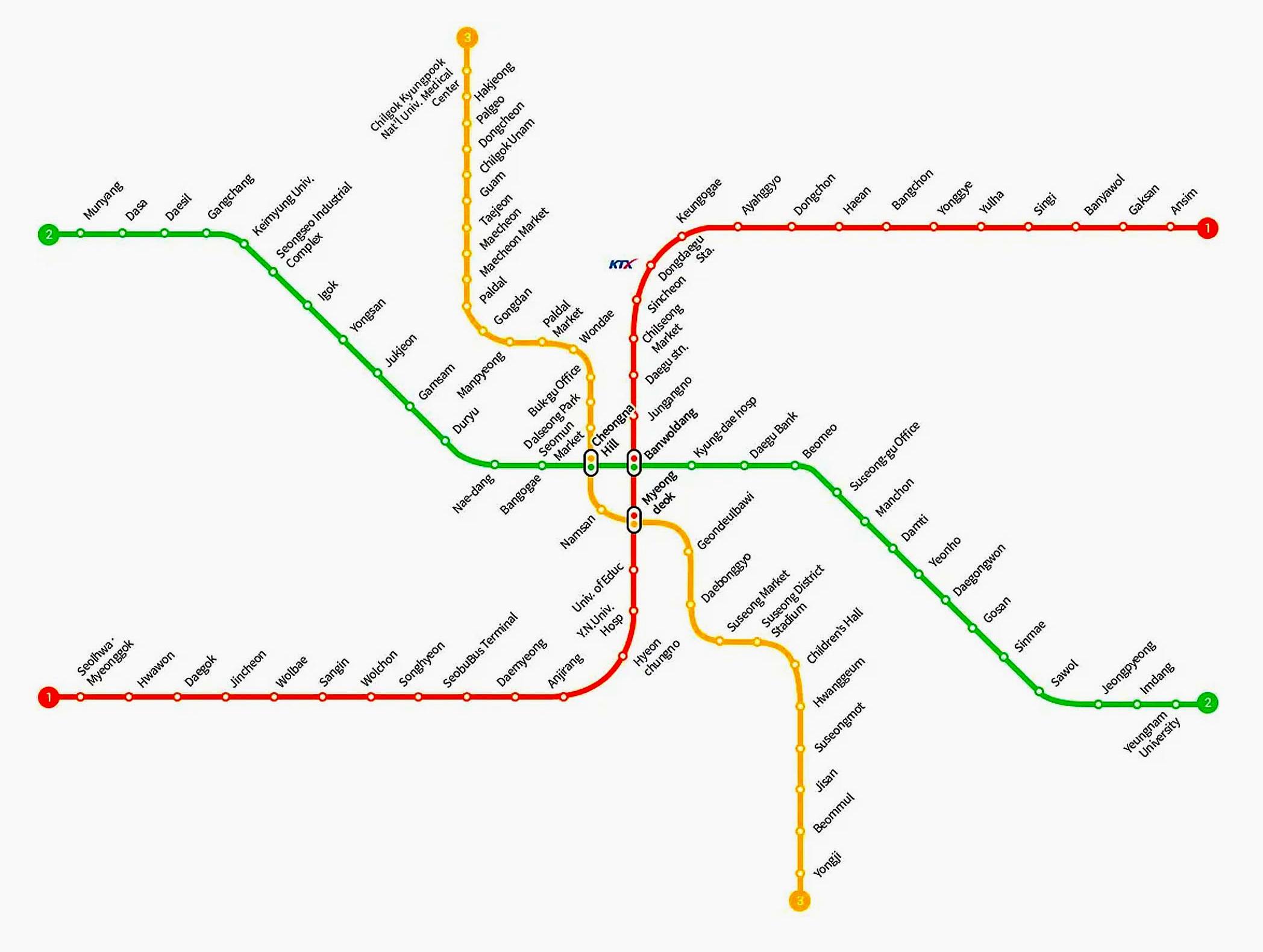Daegu Metro Information
The Daegu Metro is an underground transportation network serving the people of Daegu, South Korea. It currently has 2 rapid transit lines and 1 monorail line in operation. These 81.2 km of rail serve nearly 90 stations in total. The metro system began operations in 1997 and is operated by the Daegu Metropolitan Transit Corporation.
The Daegu Metro, also known as the subway, is an important part of the city’s transport system, serving around 301,000 passengers daily. However, it does not operate 24 hours a day, but only from 5:30 a.m. to midnight.
Although the subway system does not have air conditioning, it does have screen doors on the platforms of lines 1 and 2 for increased safety. It is not possible to walk between platforms and all trains are operated by drivers; there are no driverless trains.
A trip on the Daegu Metro costs 1 unit of local currency.
Daegu Metro Map
The Daejeon Metro Map shows different lines, stations, and interchanging possibilities. Line 1, 2, and 3 are marked with red, green, and orange colors, respectively.
Map of Daegu Metro showing different lines and stations. Click on the map to enlarge it or download the Daegu Metro map in PDF format.
Hours of Operation
The Daejeon Metro system operates from 05:30 am to midnight. The average frequency of trains is 12 minutes, with slight variations depending on the line. During peak hours, trains run every 4 to 5 minutes.
Lines and Stations
The three lines cross at different stations. Line 1 and Line 2 intersect at Banwoldang station in downtown Daejeon.
Line 1
This line runs from Daegok in the south to Ansim in the east. It is entirely within the Daejeon metropolitan area, although future extensions may reach Gyeongsan City. It takes about 50 minutes to travel the entire route. It is possible to connect to the Korail and KTX lines from this line.
Major stations on this line include Daegok, Daemyeong, Hyeonchungno, National University of Education, Yeungnam University Hospital, Myeongdeok, Banwoldang, Daegu Station, Kyungpook National University, Ayanggyo, Yulha and Ansim.
Line 2
This line runs from Munyang to Yeungnam University, connecting the east and west corners of the city. A complete journey on this line takes about an hour. Major stations on this line include Munyang, Gangchang, Keimyung University, Seongseo Industrial Complex, Yongsan, Sinnam, Banwoldang, Kyungpook National University Hospital, Daegu Bank, Suseong-gu Office, Daegu Grand Park and Yeungnam University.
Line 3
Also known as Sky Rail, this is Korea’s first bi-directional urban monorail system. The monorail is operated by a driverless system. Starting from the KNU Medical Centre in the north, the line runs through the centre of the city and ends at Yongji in the south. A complete journey on this line takes about 50 minutes.
Major stations served by this line include KNU Medical Center, Taejeon, Paldal, Buk-gu Office, Dalseong Park, Seomun Market, Sinnam, Myeongdeok, Suseong-gu Stadium, Children’s Hall and Yongji.
Future Plans
An automated Gateway Transit Line is planned to be operational in the near future as part of the Daejeon Metro system.
Fares and Tickets
The fare for Daejeon Metro depends on the type of ticket and the age of the passenger. It does not vary according to the distance travelled. There are two types of tickets: RF card and token.
A deposit of 950 won is required for RF cards. The RF Card fare is 1100 won for adults (19-64 years) and 400 won for children (6-12 years). Youths (13-18 years) get a 30% discount on the adult fare. With tokens, the fare is 1200 won per adult and 500 won per child. There is no discount for youth using tokens.
Tickets can be purchased from ticket machines or at customer centres. Some ticket machines, called complementary ticket machines, are reserved for KB Pass Card, BC Card holders. Tickets must be stamped at the station entrance and exit.
Facilities and Services
The Daejeon Metropolitan Transit Corporation offers various facilities and services to ensure a comfortable journey for everyone. All stations are equipped with facilities for disabled passengers such as wheelchair lifts and elevators. Announcements are made in both Korean and English. The company also provides lost and found services. There are waiting rooms and rest rooms at the stations.
Rules
There are certain rules that must be followed to ensure the smooth running of the Metro system and the safety of passengers. Passengers should not eat or drink in the stations and should help to keep the stations clean. Animals are not allowed in stations. Objects weighing more than 32 kg or measuring more than 158 cm in total are not allowed in the stations. Smoking is prohibited in all stations and on all trains. Passengers should be aware of no-passing zones.
Tips
To make the best use of the Daejeon Metro service, please note the following:
- If there is an emergency on the train, contact the crew via the interphone.
- If you are a victim of or witness to a crime, call the crime prevention cell immediately.
- Switch off your mobile phone on the train to avoid disturbing others.
- If you fall onto the track and the train is approaching, lie down against the wall in the free space under the platform. Call for help, but don’t panic.
